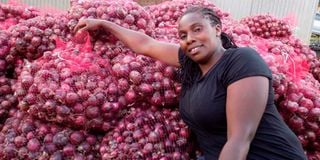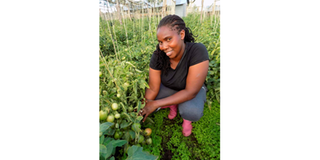Premium
From teacher to top commercial farmer

Margaret Njenga at her farm in Kiserian, Kajiado County. She grows onions, capsicum, tomatoes, spinach, cabbages, collard greens and beetroots.
What you need to know:
- In 2020, when Covid-19 hit the country and schools were closed, Margaret Njenga sought solace in farming.
- This has turned out to be one of best decisions she ever made; she has since become a successful agriprenuer.
A cool breeze wafts from the plains yonder as one approaches Corner Baridi in Kiserian, Kajiado County.
The area is cool, as the name loosely suggests. Tens of bungalows and maisonettes dot the area, owned by Kenyans seeking serenity as they work in Nairobi, where life is fast-paced.
However, Corner Baridi is not only a residential hub, commercial farming has taken root here with residents like Margaret Njenga leading from the front.
The 35-year-old farmer is busy on her onion farm with workers when the Seeds of Gold team arrives, cutting off leaves of the plants to get bulbs for the market.
“This is the last day of harvesting," says Margaret as she supervises her 27 workers having reduced the number from 40 the previous day. "I have done the harvesting in two days."
Besides onions, Margaret also farms on her four acres capsicums, cabbages, spinach, collard greens, tomatoes, beetroots as well as lucerne for her five dairy cows.
She also keeps goats, chickens, rabbits and ornamental birds.
The young farmer, an alumnus of St Johns Teachers Training College in Kilimambogo, quit teaching to engage in mixed farming. “I taught for about four years, then Covid-19 happened in March 2020. When schools were shut, I moved to Kiserian, my parents home and started to farm. I quit teaching to concentrate on farming after realising it’s well-paying," says Margaret, who initially was doing telephone farming while teaching.
Onions are her favourite crop due to their good returns. She farms them under irrigation on one acre. The rest of the crops sit on about quarter-acre each.
"I started farming onions on half-acre, investing Sh200,000 capital, money that went on installing drip lines, preparing the farm and buying seeds," she explains.
She then expanded to another half-acre, where she increased the number of drip lines for more yields, spending Sh270,000.
Seeds are among the most expensive input, she says, noting she buys a kilo at Sh30,000.
The crop takes 45 days in the nursery and 90 days in the field after transplanting, adds Margaret.
According to her, she harvests up to 15 tonnes of onions, up from eight that she would get when she was a telephone farmer.
She is currently selling a kilo of the onions at Sh70, what she says is one of the best prices as she once sold at Sh30.
“For onions, the worst thing you can do is to grow them on a small portion. It is better to invest Sh200,000 and farm on an acre, two or three. The higher the tonnage, the higher the income."
But management of the crop greatly determines what one harvests.
"When you get 15 tonnes every four to five months, that comes to over Sh1 million and you can have three seasons in a year," she says.
She sells the onions to traders from Wakulima Market in Nairobi who visit her farm.
“They collect them from the farm. It is the same case with tomatoes,” says the farmer.

Margaret Njenga at her farm in Kiserian, Kajiado County.
She rotates onions with tomatoes or cabbages that take three months to mature. “The advantage of mixed farming is that you can’t fail to get some money. Onions take some four months to mature. As I’m waiting, I sell cabbages and tomatoes, thus get income through out the year like a salaried person," she says.
Margaret grows her own seedlings inside a greenhouse in trays, cutting her cost of production.
“I grow collard greens and cabbages to get money for my sustanance and to run the farm but onions are my main crop.”
She uses manure from her livestock to grow the crops and buys more from her neighbours. She says soil testing is vital, as it guided her not to use DAP.
“I can’t use DAP according to the soil analysis report. I plant with manure, and after two weeks, I apply CAN. After four weeks I apply NPK,” says Margaret.
One of her challenges is high cost of electricity, especially when it comes to pumping water.
Also, she says farmers have no standard price for produce, what makes buyers take advantage of them.
“I can sell my onions at Sh100 per kilo, and somebody else sells at Sh20. If we had a standard price, we will make good profit.”
Some of the diseases she grapples with are downy mildew, purple blotch and bulb rot and pests such as thrips and caterpillars. But there are pesticides in the market to curb them.
When it is too hot, she waters the crops in the evening for 30 minutes. “Onions consume too much water during the first month after transplanting and in the second month. However, when they form bulbs, they require little,” she explains.
She keeps 70 chickens of Kenbro and Kienyeji varieties for meat and eggs.
“Last month I bought 100 chicks and sold 60 after a month at Sh400 each,” she says
She sells mature Kienyeji cockerels at Sh1,500 each and hens at Sh800. An egg goes for Sh20.
“Rabbits for me are for beauty. There’re those friends who I left in Nairobi, they request for farm visits. Even parents of children where I used to teach request to visit. This is a farm, a home, and also a resource centre. I started with three, they are now eight. I had five cows, all of them calved down last year, so they are now 10.”
She milks over 70 litres per day and sells to a cooperative society in Kiserian at Sh40 a litre.
“In the morning, I supply 40-45 litres. At noon I supply 25 litres, and in the evening I don’t supply,” says the farmer.
She has advice to aspiring farmers: “You only need water, determination and hope. Many people ask me why I quit teaching. It is a personal decision. Go for your goals,” says Margaret.
Her plan is to venture into value addition. “I am thinking of what I can do to my onions to increase the shelf-life. I can also use my tomatoes to make paste or sauce for more Money.”
Carol Mutua, a crop production specialist from Egerton University, says for higher yields and best quality bulbs, onions should be grown in areas with altitude of 1,000m above sea level, although reasonable harvest may be realised at lower altitudes.
“Bulbs form at relatively high temperatures. Tropical temperatures are sufficient to induce bulbing even at high altitudes. Vegetative growth best occurs at 18-250C. At temperatures less than 150C, bulbs do not form. At temperatures above 250C, bulbs assume maturity before they reach economic size resulting in low yields.“





